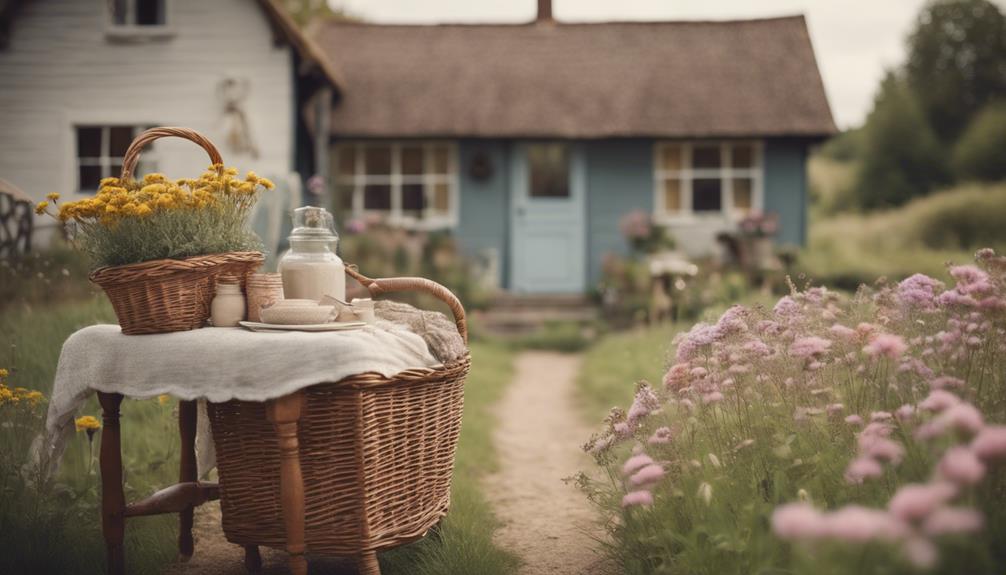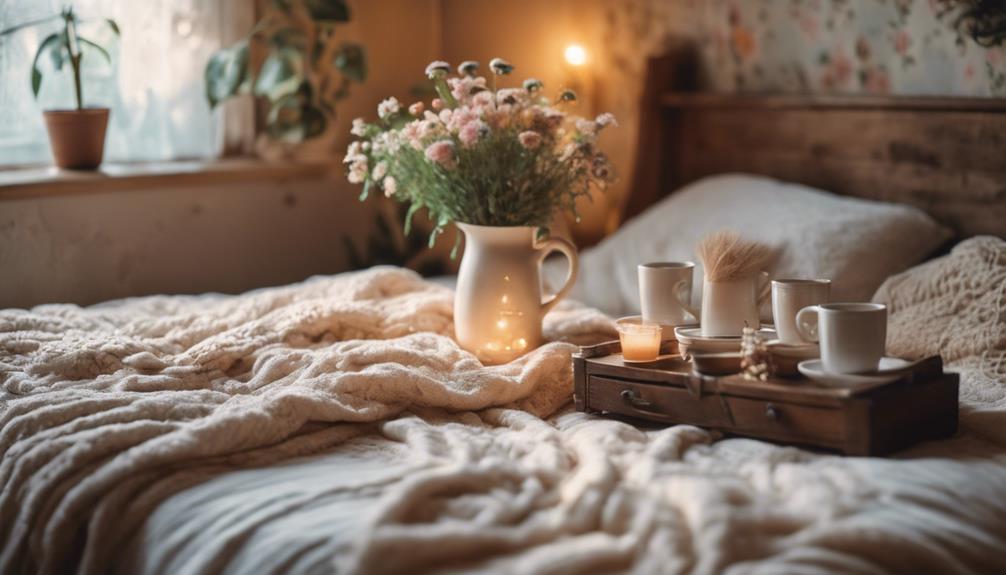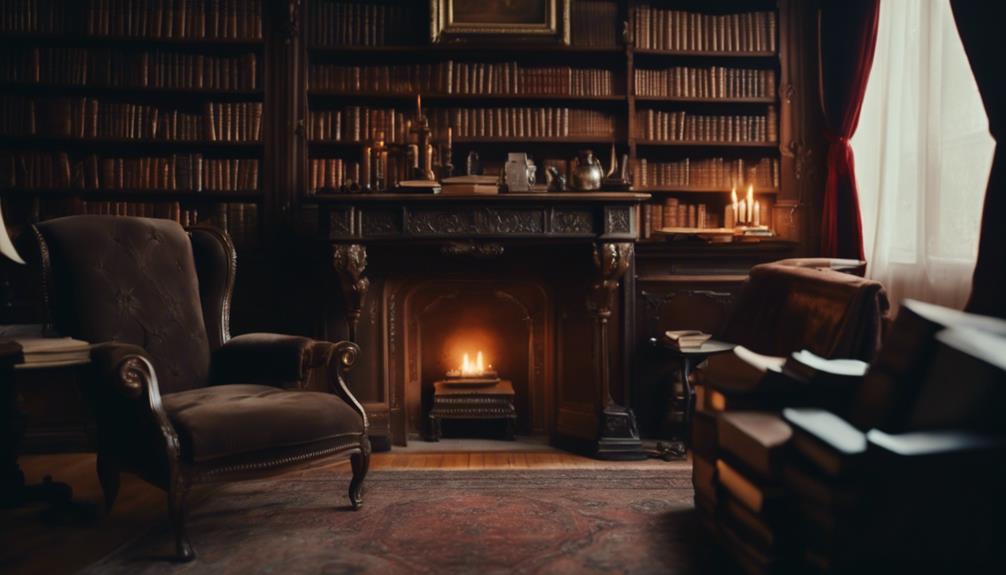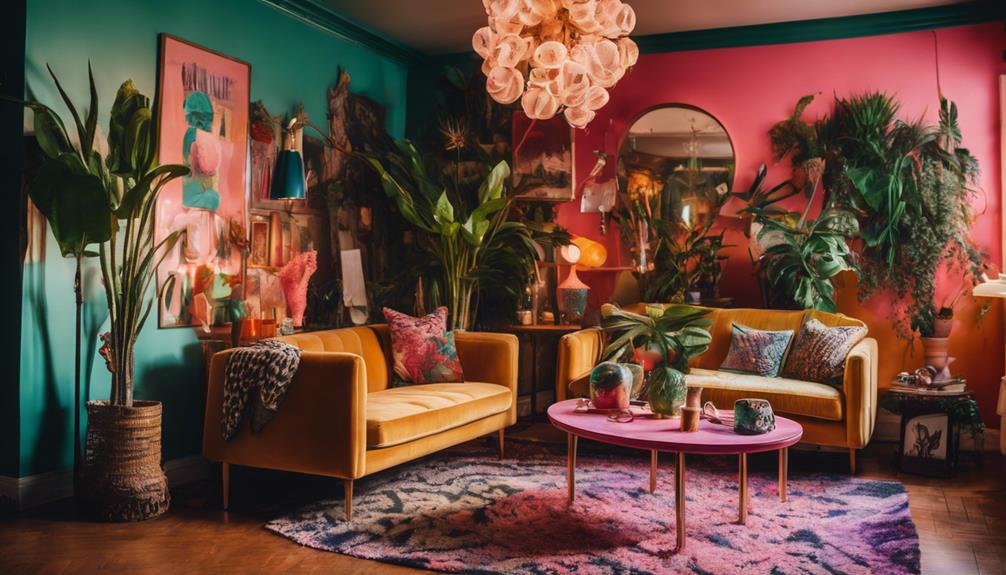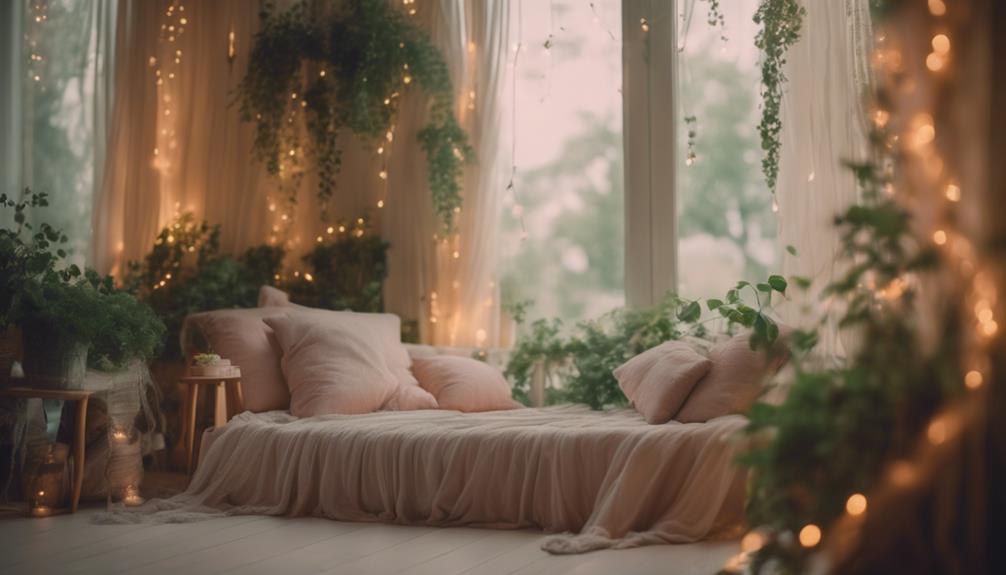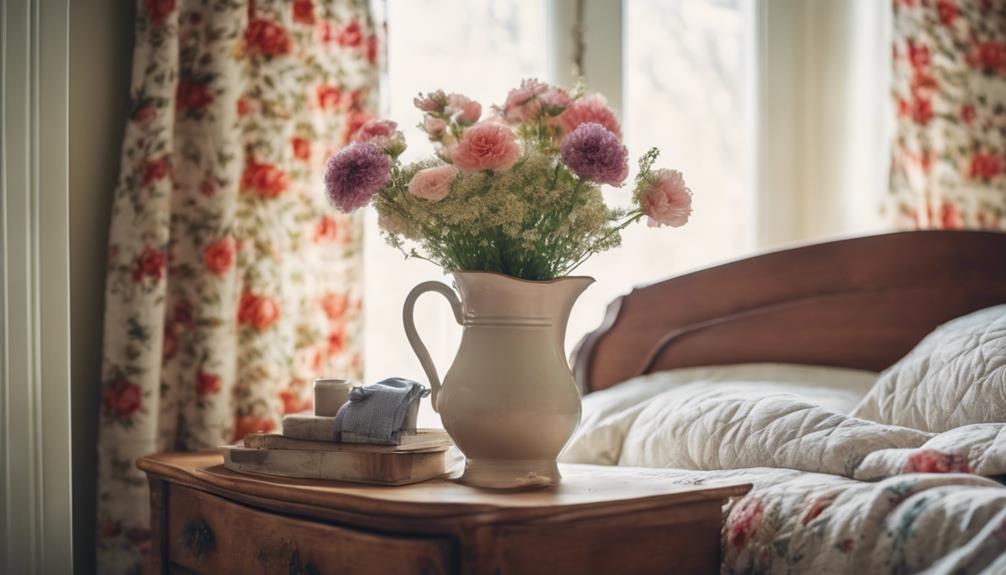Exploring the cottagecore aesthetic means embracing simplicity, nature, and nostalgia. You can choose from various styles, like Vintage Cottagecore with warm tones and antique decor or Fairy Cottagecore that highlights pastel hues and whimsical elements. Incorporating natural fabrics, decorative pieces like hand-painted ceramic vases, and inviting fixtures such as antique wooden tables creates cozy spaces. Consider lighting options like rustic candle chandeliers or fairy lights to enhance the atmosphere. With so many ways to express yourself, you're sure to find the perfect fit for your home. There's so much more to uncover about these enchanting styles!
Key Elements
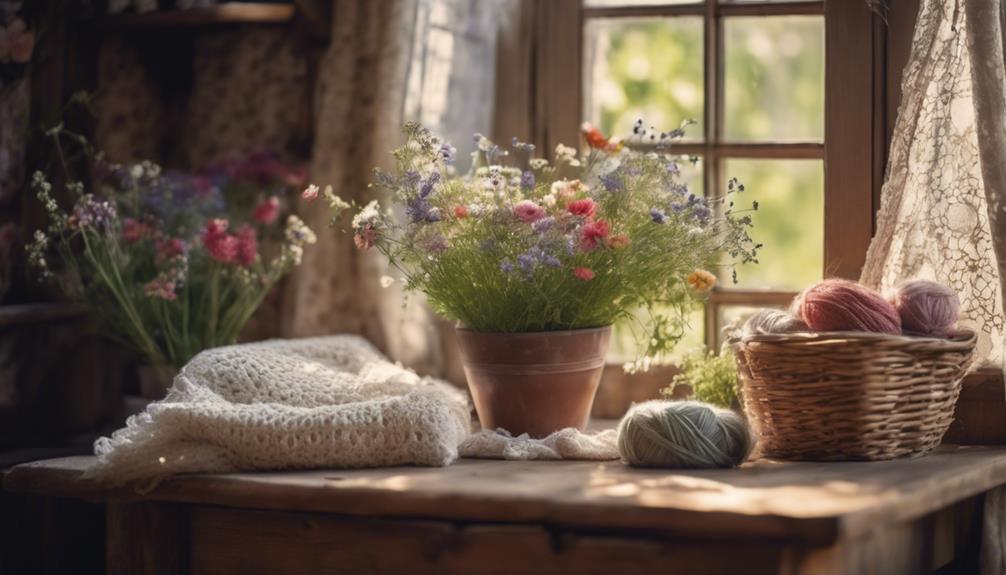
When you embrace the Cottagecore aesthetic, you'll notice the importance of color schemes, materials, and textures in creating your ideal space.
Soft, muted palettes paired with natural materials help evoke a sense of tranquility and nostalgia.
You'll find that each texture and hue plays a vital role in establishing the cozy, rustic vibe you're aiming for.
Color Scheme
Cottagecore color schemes embrace muted tones like sage green and dusty pink, creating a natural and serene atmosphere that draws you into a whimsical world. The color palette often includes rusty orange, mint green, pale pink, and cream, which evoke a sense of calm and nostalgia. Depending on the subtype of the Cottagecore aesthetic you identify with, your color choices can vary considerably.
For instance, if you lean towards Fairy Cottagecore, you might favor pastel colors and vibrant hues that bring a playful energy to your space.
On the other hand, Vintage Cottagecore emphasizes warm and earthy tones, perfect for showcasing vintage pieces that tell a story.
Light Cottagecore focuses on bright, airy colors that enhance natural light, while Dark Cottagecore, or Cottagegore, utilizes deep greens and rich browns to create a brooding yet sophisticated ambiance.
If you prefer a more minimalist approach, you can blend simple color choices with natural textures, emphasizing whites and neutrals for a clean and cozy aesthetic.
Whatever your preference, the right color scheme can beautifully encapsulate your Cottagecore style.
Materials
Natural materials like cotton, linen, and wool are crucial to the Cottagecore aesthetic, reflecting a love for sustainability and comfort in both fashion and home decor. When you embrace Cottagecore, you'll find that these materials create a cozy, inviting atmosphere that feels both rustic and timeless.
In fashion, look for flowing dresses and puff sleeve tops made from breathable fabrics that offer both style and ease of movement. Vintage elements, such as floral patterns and gingham prints, evoke a sense of nostalgia and charm, making your outfits feel effortlessly romantic.
For home decor, focus on incorporating items like vintage pottery and embroidered linens. These natural materials not only add a personal touch but also enhance the rustic vibe that defines Cottagecore. Distressed furniture, with its worn and weathered appearance, fits perfectly into this aesthetic, inviting warmth and history into your space.
Don't forget accessories! Wicker baskets, straw hats, and hand-knit items are crucial for completing your Cottagecore look. They emphasize your connection to nature and the simplicity that this lifestyle celebrates, helping you cultivate a serene, comforting environment.
Textures
How do textures enhance the Cottagecore aesthetic? They create a warm, inviting atmosphere that embodies the charm of rustic living. By incorporating natural materials like linen, cotton, and wool, you'll cultivate a cozy vibe in both fashion and home decor. These textiles not only feel good to touch but also evoke a sense of simplicity and comfort.
Floral prints and botanical patterns play an essential role in creating layered textures, infusing your space with romantic and pastoral themes. You can elevate the aesthetic further by adding hand-embroidered details and crochet elements, which highlight the DIY spirit of Cottagecore.
For a truly rustic look, consider incorporating elements like distressed wood and vintage pottery. These items not only add depth but also evoke nostalgia, making your space feel lived-in and loved.
If you lean towards the Fairy Cottagecore style, opt for soft, flowing fabrics like tulle and lace. These materials create a whimsical, ethereal feel that beautifully complements the overall aesthetic.
Essential Fixtures and Furniture
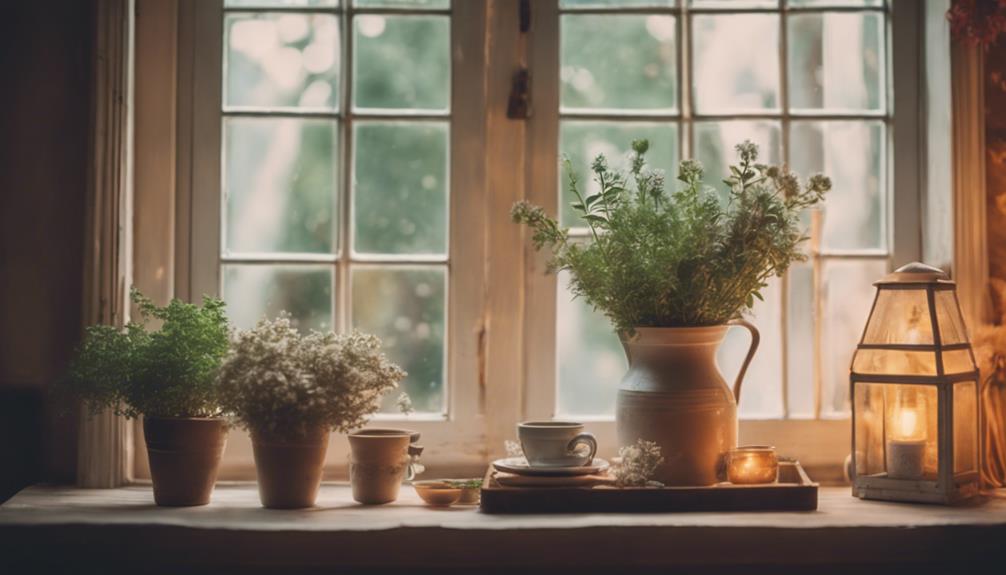
To create a true Cottagecore vibe, you'll want to incorporate essential fixtures like an antique wooden dining table, which serves as a warm gathering place.
A vintage floral armchair adds a cozy touch, inviting you to relax with a book.
Don't forget woven willow storage baskets; they're perfect for keeping your space tidy while enhancing that rustic charm.
Antique Wooden Dining Table
An antique wooden dining table becomes the heart of your cottagecore aesthetic, radiating rustic charm and inviting warmth into your home. This centerpiece not only emphasizes the beauty of natural materials but also enhances the cozy atmosphere typical of rustic homes. The unique grain patterns and imperfections found in these tables celebrate the beauty of age and craftsmanship, making each piece a conversation starter.
When choosing an antique wooden dining table, consider styles like farmhouse tables. These sturdy constructions are perfect for communal dining experiences, encouraging connection and togetherness. Pair your table with vintage tableware and floral centerpieces to amplify its charm, creating an inviting space for meals and gatherings.
Additionally, many antique tables incorporate reclaimed wood, aligning with cottagecore values of sustainability and environmental mindfulness. By opting for a piece that tells a story, you're not just furnishing your home; you're embracing a lifestyle that appreciates the past.
An antique wooden dining table truly embodies the essence of cottagecore, making it an essential fixture in your design journey. Embrace this timeless piece and watch as your dining area transforms into a warm and welcoming haven.
Vintage Floral Armchair
A vintage floral armchair complements your antique wooden dining table beautifully, bringing a touch of whimsy and comfort that enhances the cozy, nature-inspired vibe of the cottagecore aesthetic. These armchairs often feature intricate upholstery with botanical patterns, making them a perfect addition to your space. You can find vintage floral armchairs in various styles, like Victorian, Edwardian, or mid-century, allowing you to express your unique taste while keeping with the vintage theme.
Incorporating natural materials is key to the cottagecore aesthetic, and these armchairs typically use wood for the frame and organic fabrics like cotton or linen for the upholstery. This not only aligns with eco-friendly values but also promotes a warm and inviting atmosphere. Imagine curling up in your vintage floral armchair with a good book, creating a cozy reading nook that embodies the slower-paced, homey lifestyle of cottagecore.
Sourcing these armchairs from antique shops or thrift stores not only supports sustainability but also adds unique character to your home. With their charm and comfort, vintage floral armchairs are essential fixtures that truly capture the essence of the cottagecore aesthetic.
Woven Willow Storage Basket
Woven willow storage baskets effortlessly blend functionality with rustic charm, making them essential fixtures in any cottagecore-inspired home. Crafted from natural materials, these baskets embody the eco-friendly ethos central to the Cottagecore aesthetic. Their vintage and rustic designs evoke a sense of nostalgia, perfect for organizing your space while enhancing its beauty.
Available in various sizes and styles, woven willow storage baskets serve multiple purposes. You can use them to store blankets, magazines, or even your gardening supplies, ensuring everything has its place while maintaining a cozy atmosphere. The intricate weaving patterns add texture and visual interest, making these baskets not just practical but also attractive decorative elements.
Incorporating woven willow storage baskets into your decor helps create a warm and inviting environment. They reflect the pastoral themes important to cottagecore living, allowing you to embrace a lifestyle that values simplicity and nature.
Lighting Ideas
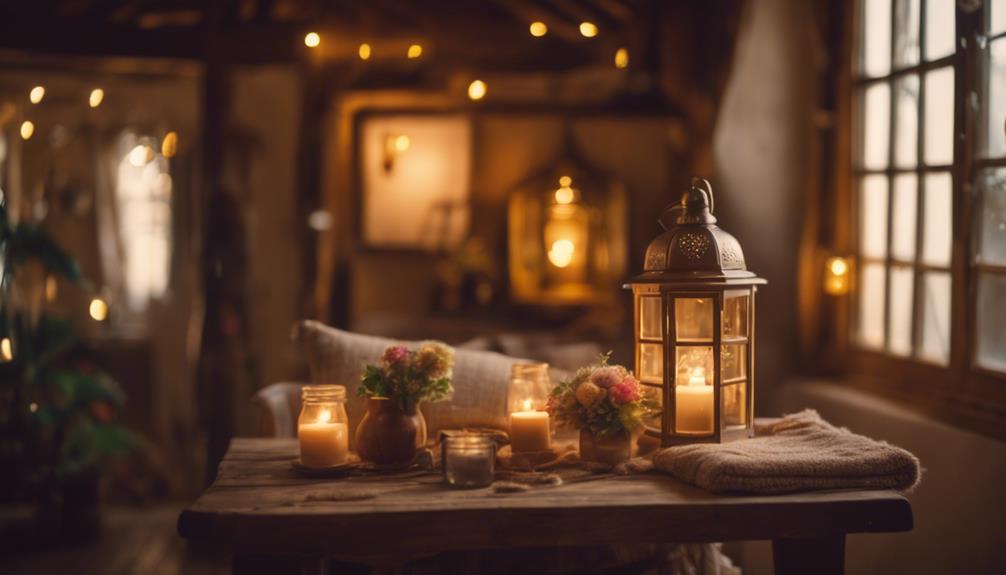
When you think about lighting in a cottagecore space, consider using antique lanterns to create a warm ambiance.
Vintage glass pendant lights and rustic candle chandeliers add a charming touch, while fairy light string installations can bring a magical feel to your home.
These elements not only enhance your decor but also foster a cozy, inviting environment.
Antique Lanterns for Ambiance
Antique lanterns create a warm, inviting ambiance that perfectly complements the cottagecore aesthetic. Often crafted from natural materials like brass and glass, these lanterns evoke a sense of nostalgia and add a rustic charm to your space. You can use them both indoors and outdoors, providing ambient lighting that enhances cozy gatherings or quiet evenings in your garden or living room.
Many antique lanterns feature intricate designs and exceptional craftsmanship, making them not just functional but also decorative focal points in your cottagecore-inspired decor. You'll find that incorporating these lanterns promotes a connection to history and tradition, reinforcing the themes of simplicity and nature within your overall design.
If you're on the lookout for unique finds, consider visiting flea markets, antique shops, or online marketplaces, where repurposed or vintage lanterns often await. Each piece can reflect your personal style while enriching the cottagecore aesthetics you love.
Vintage Glass Pendant Lights
Building on the warm ambiance created by antique lanterns, vintage glass pendant lights add a nostalgic touch that beautifully enhances your cottagecore decor.
These lights come in various styles, such as milk glass, colored glass, and textured designs, which perfectly complement the cottagecore aesthetic. With intricate details like etching and frosted finishes, they bring charm and character to your space while creating a warm, inviting atmosphere.
Using vintage glass pendant lights, you can achieve soft, diffused lighting, which is ideal for cozy nooks reminiscent of a rustic cottage. When selecting your lights, consider mixing different shapes and colors to create a unique arrangement that reflects your personal style. This playful approach adds depth and interest to your lighting scheme.
Moreover, many of these pendant lights are eco-friendly, often crafted from repurposed materials. This aligns beautifully with the cottagecore principles of sustainability and an appreciation for natural materials.
Rustic Candle Chandeliers
Transform your space with rustic candle chandeliers that infuse warmth and charm, perfectly capturing the essence of cottagecore aesthetics.
These stunning fixtures often feature natural materials like wood and wrought iron, enhancing your decor with a warm and inviting ambiance. Imagine the soft glow of taper or pillar candles illuminating your dining room or living area, creating a cozy atmosphere ideal for gatherings or quiet evenings.
Rustic candle chandeliers can be adorned with elements like dried flowers or greenery, establishing a beautiful connection to the beauty of nature that resonates with the cottagecore theme. Whether you prefer farmhouse, vintage, or bohemian styles, you'll find a chandelier that reflects your unique taste while adding character to your space.
These versatile lighting options are perfect for both indoor and outdoor settings, making them an excellent choice for patios or cozy nooks. By incorporating a rustic candle chandelier, you not only elevate the charm of your home but also embrace the tranquility and simplicity that the cottagecore aesthetic embodies.
Illuminate your life and embrace the rustic charm today!
Fairy Light String Installations
Fairy light string installations instantly add a touch of whimsy and enchantment to your cottagecore-inspired space. These charming fairy lights can be draped over furniture or hung from ceilings, emulating a starry night and inviting a sense of tranquility into your room. By incorporating warm white or pastel-colored fairy lights, you'll complement the soft, muted palette typical of cottagecore designs, creating a cozy environment that feels inviting and serene.
You have plenty of flexible placement options to personalize your space. Try wrapping fairy lights around plants, using them in DIY decor projects, or weaving them through natural materials like branches or dried flowers. This creativity allows you to showcase your individual style while enhancing the overall aesthetic.
Additionally, fairy lights are often energy-efficient, making them a sustainable choice for your home. This not only elevates the enchanting atmosphere but also promotes environmental consciousness.
Decorative Elements
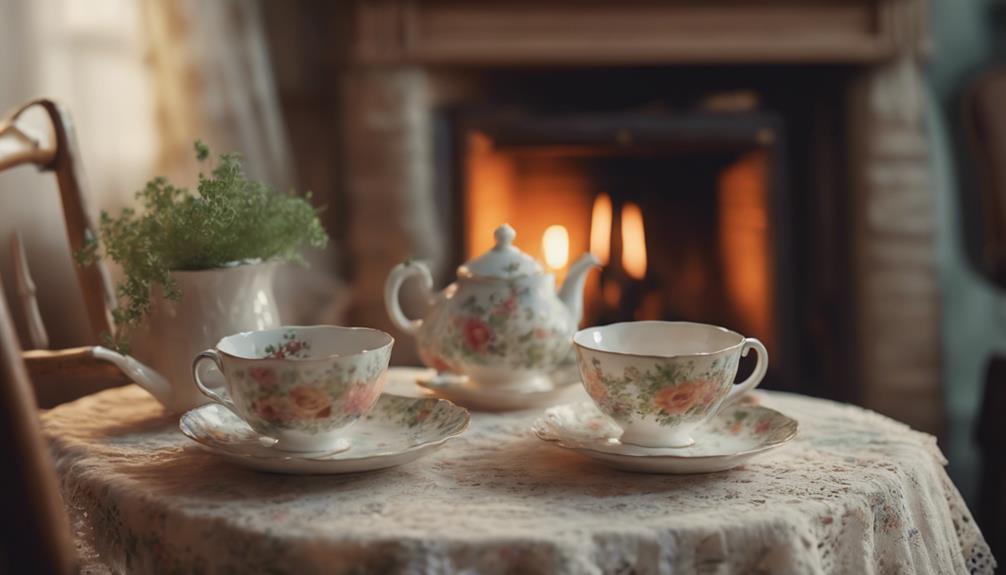
When it comes to decorative elements in cottagecore, you'll want to focus on items that embody nature and nostalgia.
Think of a dried flower wall hanging that brings the outdoors in, hand-painted ceramic vases that add a touch of artistry, and embroidered linen table runners that make your dining space feel inviting.
Each piece you choose can enhance the cozy, whimsical vibe that defines the cottagecore aesthetic.
Dried Flower Wall Hanging
A dried flower wall hanging adds a touch of natural beauty to your Cottagecore-inspired space, effortlessly blending aesthetics with sustainability. These decorative elements capture the essence of nature, making them ideal for enhancing your home's unique style. You can choose from various dried flowers, like lavender, eucalyptus, and baby's breath, each contributing distinct textures and scents to your decor.
Creating your own dried flower wall hanging is an enjoyable project that promotes the use of natural materials. Simple techniques, such as arranging and securing flowers on a wooden frame or using embroidery hoops, allow you to craft a piece that reflects your personality.
This customization guarantees that your wall hanging doesn't just beautify your space but also tells your story.
Hand-Painted Ceramic Vase
Hand-painted ceramic vases bring a charming touch to your Cottagecore decor, showcasing intricate floral designs and soft colors that echo the beauty of nature. These vases often feature delicate floral patterns, allowing you to incorporate the essence of the outdoors into your home. Their artisanal craftsmanship creates stunning focal points that enhance any room's ambiance.
You can use a hand-painted ceramic vase to display freshly picked wildflowers or dried arrangements, emphasizing the rustic charm of the Cottagecore aesthetic. By choosing vases made from natural materials, you not only support the environment but also add to the organic feel of your space. Each piece reflects the unique style and creativity of the artist, giving your decor a personal touch.
Moreover, opting for locally crafted vases aligns perfectly with Cottagecore values, promoting sustainability and appreciation for handmade crafts. As you curate your Cottagecore haven, consider how hand-painted ceramic vases can harmonize with other elements, creating warmth and inviting tranquility.
Embrace the artistry and individuality that these vases offer, and let them breathe life into your decor.
Embroidered Linen Table Runner
Embroidered linen table runners add a touch of elegance and warmth to your Cottagecore decor, beautifully showcasing intricate designs that reflect the charm of nature. As a quintessential decorative element within the Cottagecore aesthetic, these table runners embody the appeal of handmade crafts and natural materials.
You'll find that many embroidered linen table runners feature floral designs or vintage motifs, enhancing the rustic and romantic ambiance typical of Cottagecore spaces. Linen is particularly favored for its breathable quality and eco-friendliness, aligning perfectly with the sustainability values central to this lifestyle.
Incorporating an embroidered linen table runner can transform your dining experience, creating a cozy atmosphere ideal for gatherings and seasonal celebrations. The soft, muted colors in these linens seamlessly complement the Cottagecore palette, ensuring a cohesive look that enhances the overall aesthetic of your inviting space.
Whether you're setting a table for a simple afternoon tea or a festive dinner party, an embroidered linen table runner serves as a focal point, inviting warmth and charm into your home. Embrace this beautiful piece in your decor, and let it reflect your unique take on the Cottagecore aesthetic.
Flooring
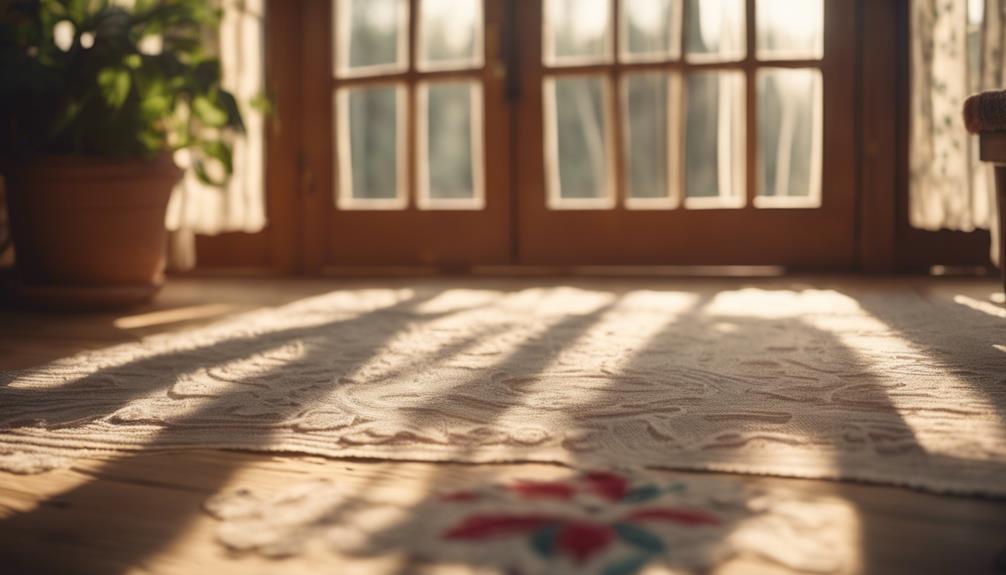
When it comes to flooring in the Cottagecore aesthetic, you'll want to focus on natural materials that bring warmth and charm to your space.
Reclaimed wood plank flooring, natural stone tiles, and cottage-style patterned ceramic tiles can all enhance that cozy, nostalgic vibe.
Each option not only complements the overall aesthetic but also invites a connection to nature that defines Cottagecore.
Reclaimed Wood Plank Flooring
Have you ever considered how reclaimed wood plank flooring can transform your space with its unique character and sustainability? This flooring, sourced from old buildings and barns, brings a rustic charm that perfectly aligns with cottagecore style. Each plank tells a story, featuring distinctive patinas, knots, and grain patterns that give your home a unique look, setting it apart from mass-produced options.
Opting for reclaimed wood is also an eco-friendly choice, as it repurposes materials that would otherwise go to waste. This not only reduces the demand for new lumber but also connects you to the natural materials that define the cottagecore aesthetic. The installation costs generally range from $5 to $15 per square foot, depending on the wood species and finish you choose.
To maintain the beauty of your reclaimed wood flooring, regular cleaning and occasional refinishing are vital. By doing so, you guarantee the longevity of this stunning feature while preserving its rustic appeal. Embrace the warmth and history of reclaimed wood, and let it enhance the cozy atmosphere of your cottagecore-inspired home.
Natural Stone Tile Flooring
Natural stone tile flooring offers a stunning blend of durability and eco-friendliness, making it a perfect choice for those embracing the cottagecore aesthetic. This flooring option is crafted from natural materials like granite, marble, limestone, and slate, which are sourced directly from the earth. The unique variations in color and texture found in each stone slab create one-of-a-kind designs that enhance your space with authentic cottagecore charm.
With its natural earth tones, stone flooring seamlessly integrates into a cozy, rustic environment, providing warmth and character to your home. Plus, its long lifespan—often exceeding 50 years—makes it a cost-effective choice. You'll love how stone regulates temperature, keeping your home comfortable in any season, while also contributing to energy efficiency.
Caring for your natural stone tile is straightforward; regular sealing protects against stains and moisture, while pH-neutral cleaning products help maintain its integrity. By choosing natural stone tile flooring, you're not just investing in a beautiful aesthetic; you're also embracing sustainability and durability, hallmarks of the cottagecore lifestyle.
Cottage-Style Patterned Ceramic Tiles
Cottage-style patterned ceramic tiles bring a whimsical touch to your floors, featuring floral designs and soft color palettes that perfectly embody the charm of the Cottagecore aesthetic. These tiles often showcase intricate patterns like vines and leaves, enhancing the cozy atmosphere typical of Cottagecore interiors. By incorporating these charming designs, you can transform spaces into inviting havens.
Durability is key, as these tiles are made from natural materials, making them suitable for high-traffic areas in your rustic home. Their robustness doesn't compromise beauty; they combine practicality with aesthetic appeal. Plus, maintaining and cleaning ceramic tiles is a breeze, aligning seamlessly with the Cottagecore lifestyle focused on simplicity and functionality.
You'll find that using cottage-style patterned ceramic tiles in kitchens and bathrooms creates a delightful connection to nature, reinforcing the overall theme of harmony with the environment. The vintage-inspired motifs add a timeless quality, making your home feel like a serene retreat.
Conclusion
Now that you've explored the different types of cottagecore aesthetic, it's time to find the style that resonates with you.
Whether you prefer rustic charm, floral prints, or cozy nooks, each element can transform your space into a serene retreat.
Embrace the warmth of essential fixtures, play with lighting, and add those personal touches that speak to your heart.
Immerse yourself in your perfect cottagecore vibe, and let your home reflect the tranquility and beauty you crave!
